- Section A: General Information
- Section B: Information about your Illnesses, Injuries, or Conditions
- Section C: Information about Daily Activities
- Section D: Information About Abilities
- Section E: Remarks:
- Walkthrough
5 Tips for completing the Adult Daily Living Form 1
Section A: General Information
Provide your general contact information and information about your living situation.
Note: Even if you do not have a reliable telephone number, it is important that you provide a phone number where SSA can leave a message for you (if possible). SSA may deny your claim if they cannot reach you for critical information.
Section B: Information about your Illnesses, Injuries, or Conditions
This section asks you to describe how your illnesses, injuries, or conditions limit your ability to work. Consider the following when completing this section:
- How is your mobility?
- Mobility refers to any struggles you have with moving around. Walking, getting out of a chair, or bending over are all common mobility problems for people applying for disability benefits.
- Are you in pain?
- What is your average pain level? Does it increase/decrease throughout the day?
- What is the location of your pain?
- If your impairment is related to mental health, do you experience:
- Sadness
- Crying spells
- Anxiety
- Irritability
- Isolation
This section is your opportunity to describe why you cannot work in your words. Be concise, be honest, and be specific.
1 This guide is intended to be for informational purposes only and should not be construed as legal advice. Your answers should be honest, in your own words, and based on your own specific circumstances.
Section C: Information about Daily Activities
This section asks you to describe what you do from the time you wake up until you go to bed. Remember the following when completing this section:
- Be honest. Do not exaggerate but also remember not to downplay your limitations. It is expected that you will have “good” and “bad” days. What is an average day like for you?
- Be specific. Many of the questions in this section are about what you can do. SSA does not require that you be unable to meet your basic needs to receive benefits, but it is important to communicate any struggles that you may have while completing daily tasks.
- Caring for others:
- If you provide care to a spouse, child, or grandchild, it is expected that you meet their basic needs. However, do you struggle to do so? How does this care impact how you feel?
- Caring for pets:
- Again, it is ok that you specify that you meet a pet’s needs; i.e. feeding, walking, etc. How does such care impact your physical or mental well-being? Do you have assistance caring for your pet(s)?
- Personal Needs and Grooming:
- Are you able to perform activities related to personal care on your own or do you need assistance? If you need assistance, why?
- Do you need reminders? Do you avoid activities, such as basic hygiene, for reasons related to your impairments?
- Meals:
- Do you make food for yourself or does someone help you?
- If you prepare meals for your family, are you able to do so all at once or do you require breaks?
- Household Chores:
- You should not be expected to allow your home to fall into disrepair in order to be found disabled. For that reason, it is ok to specify if you do chores around the house. The key is to be specific about any limitations you have in doing them.
- For example, if you mow your yard, do you require multiple breaks to finish? How big is your yard?
- Also, if you do laundry, do you carry the basket of clothes or does someone else?
- Getting around:
- Specify not only how often you go outside, but also how long you go out when you do.
- Shopping:
- If you shop in a store, do you utilize any assistance navigating the store such as a motorized cart?
- Money:
- Even if you are able to handle paying bills, managing money, etc., there is a section to specify how that has changed since your impairments have begun. This would be the place to specify if you need any help paying bills or managing your money.
- Hobbies and Interests:
- This section invites you to describe your hobbies and interests. Be specific about how well, how often, and for how long you can do these activities.
- Most hobbies involve sitting and focusing on a task for a prolonged period of time. Do you have any limitations doing so? For example, if watching television or reading a book is your hobby, how long can you do so for a sustained period? What happens then?
- Social Activities:
- How is the quality of social interaction you have? Do you have angry outbursts with friends, family, or neighbors? Do you feel apprehensive or scared about leaving the house?
- Do you need someone to take you to social events? When you do go out, do you interact with others or keep to yourself?
- Any change in social activities that you previously were interested in can be insightful. If you have been an active member in a church group, but lost interest due to depression or anxiety for example, Social Security will take that into consideration when determining whether you can work a job involving public contact.
Section D: Information About Abilities
This section asks you to explain any functional limitations you experience due to your conditions. This section is important because it requires you to describe your ability to do certain activities that would be required in a work setting, such as standing, walking, sitting, concentrating, following directions, etc.
Avoid answers that are generalizations, such as “I cannot stand very long,” or “I do not follow instructions well.” The goal is to paint a picture of your functional limitations for SSA so that they can compare those limitations with what would be required in a work setting.
Always consider constructing your answers with “because” in mind:
Examples:
- I cannot stand very long because standing causes a burning pain in my lower back and weakness in my legs.
- I do not follow directions well because I need directions repeated or need to reread them multiple times.
- I can only use my hands for short periods of time because they start to go numb and cramp up.
As always, you should be honest and use your own words. The key is to give SSA a clear picture regarding the reason you are limited in these areas.
Assistive Devices (Cane, Walker, Crutches, Etc.):
Make sure you check all that apply even if you use them infrequently. If a doctor did not prescribe these items but recommended their use, make sure you specify that point in Section E: Remarks.
Medicines:
This section asks whether you take any medications for your illnesses, injuries, or conditions. Remember that this section only asks you to list your medications if they cause side effects, such as drowsiness, fogginess, nausea, etc.
If any of your medications do cause side effects, consider notifying your doctor about those side effects as well so that it is documented in your medical records.
Section E: Remarks:
Unless otherwise specified in this guide, the remarks section is a place where you can add any additional information regarding your conditions, limitations, and how they impact your day to day life. It is important to be concise and avoid providing any information that conflicts with what you have already stated in the form.
Walkthrough
- Section A and B-General Information and Information about Your Illnesses, Injuries or Conditions:
- For Section A, make sure you fill out your full legal name as listed on your Social Security Card. Also make sure that you add your Social Security Number and a phone number that someone can reach you at.
- For Section B, be detailed. Explain how your conditions impact you.
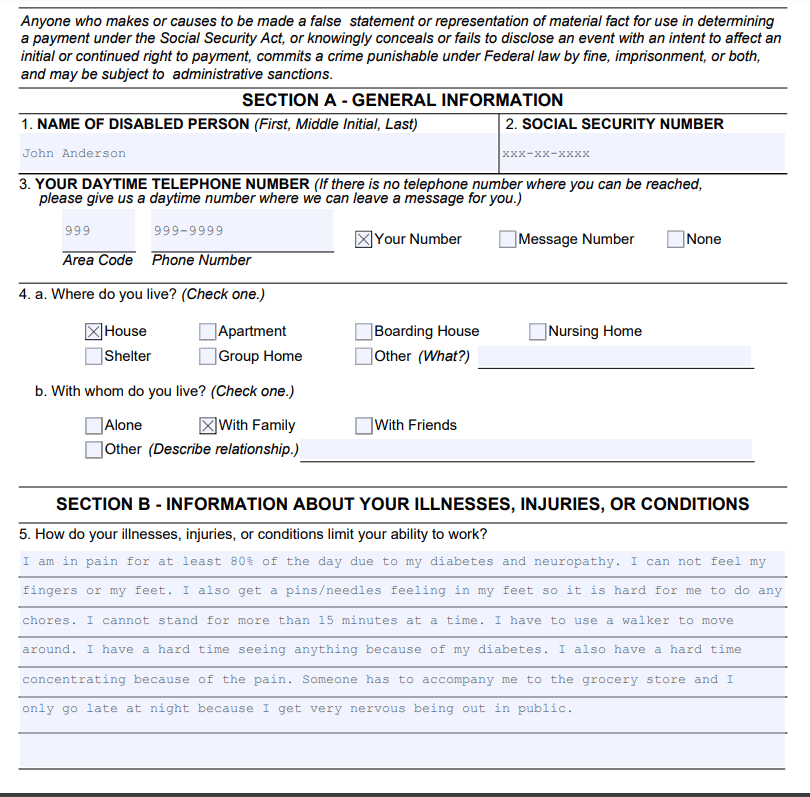
- Section C: Information about Daily Activities.
- Describe what you do from the time you wake up until going to bed: Write down a summary about what you do during a typical day.
- Make sure to provide examples if stated in the questions.
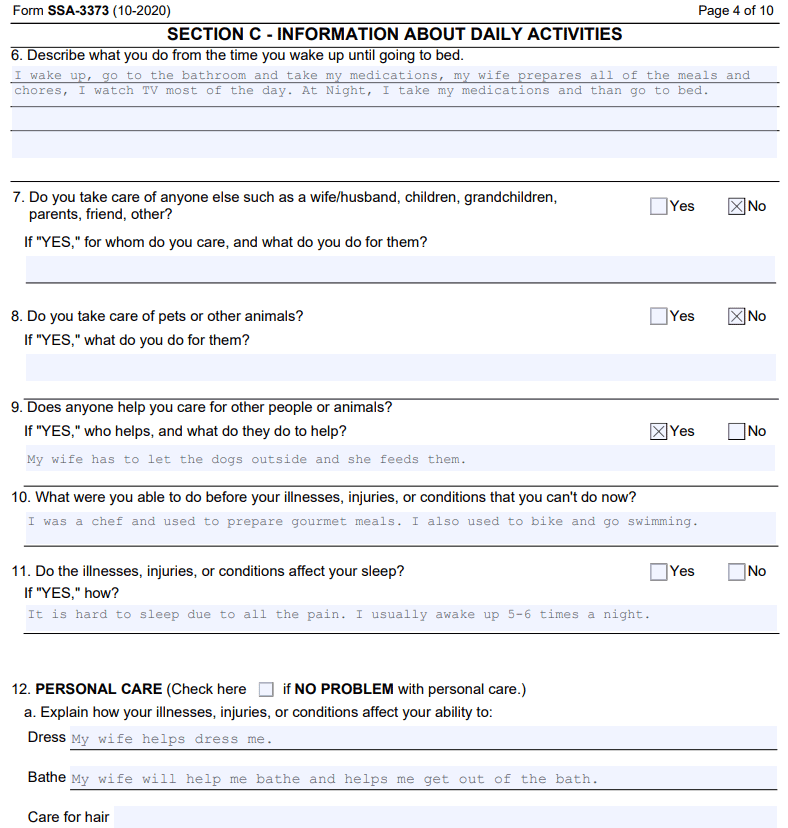
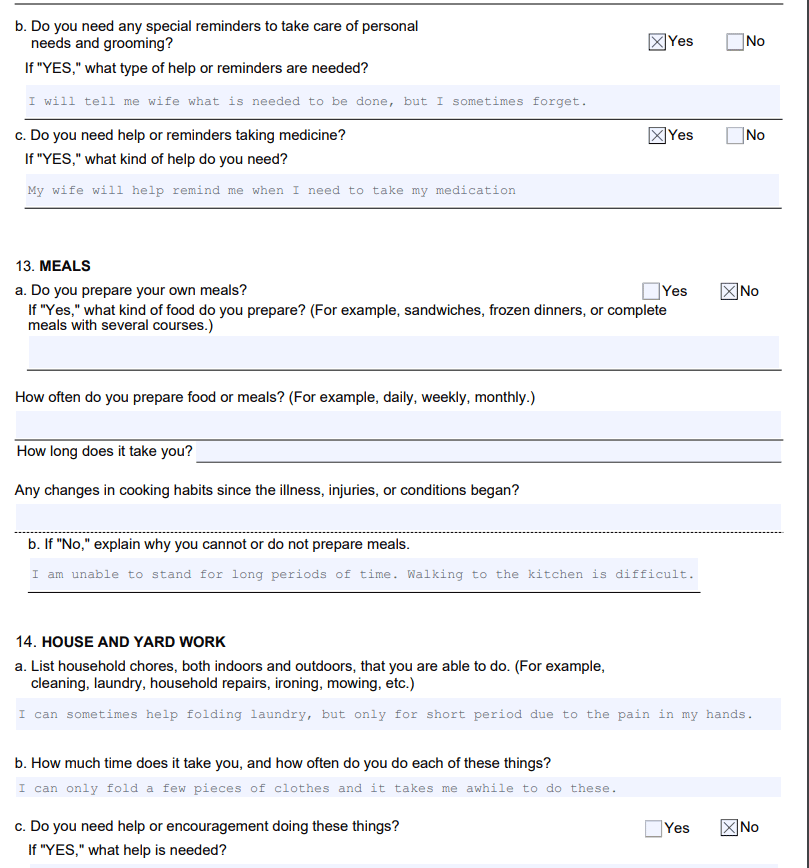
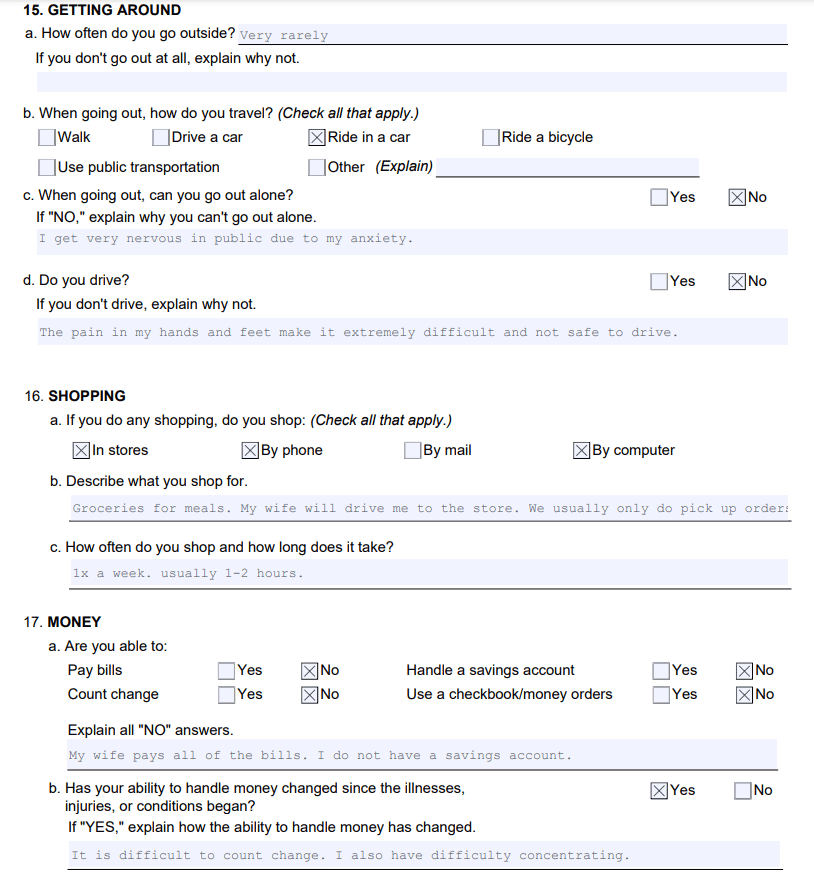
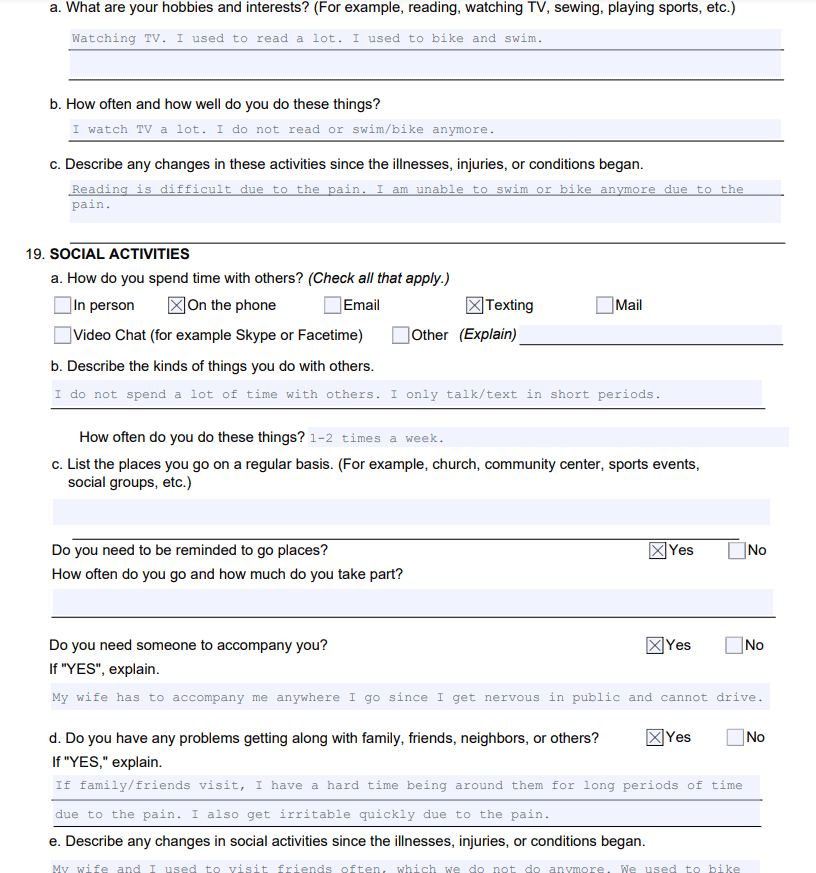
- Section D: Information about Abilities:
- Make sure you select any abilities that are impacted by your conditions.
- You will want to be detailed when you explain how your conditions affect each of the abilities you selected.
- On the bottom of the form, make sure you list your medications and any side effects you experience from them
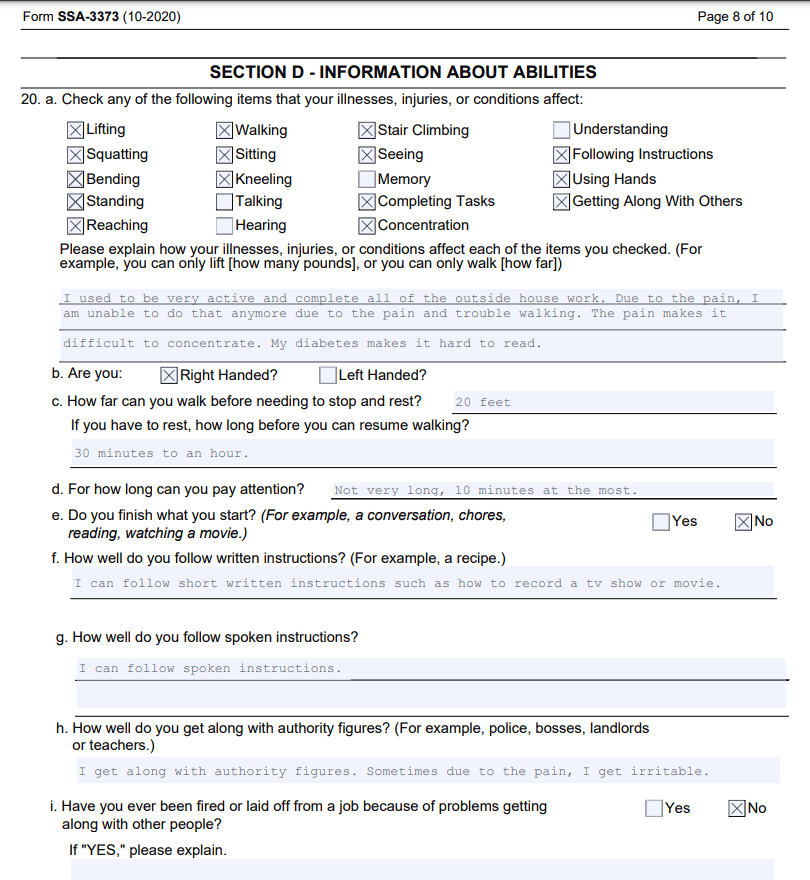
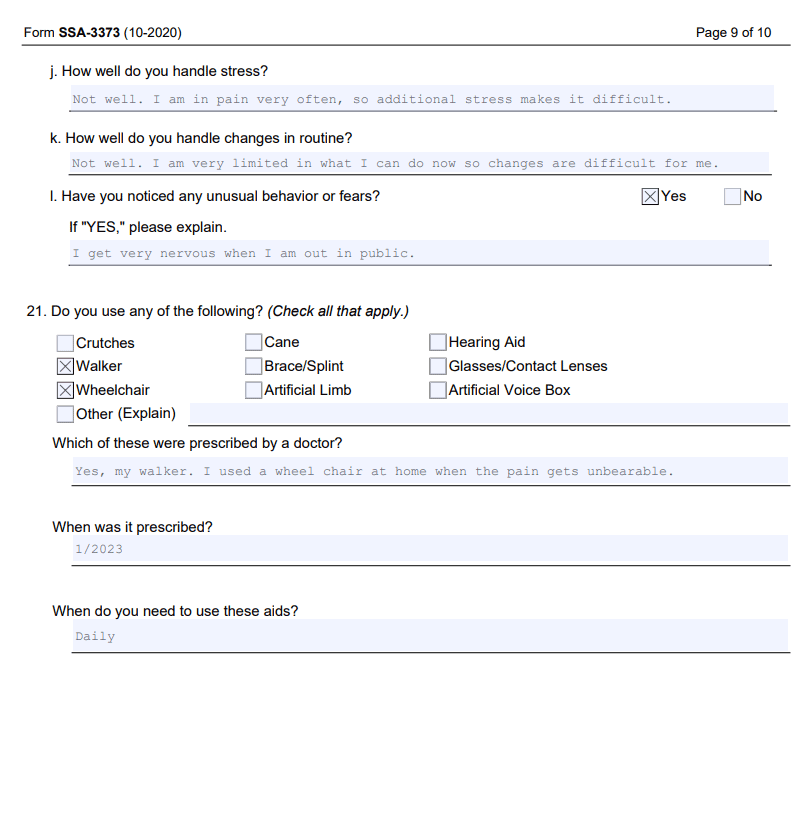
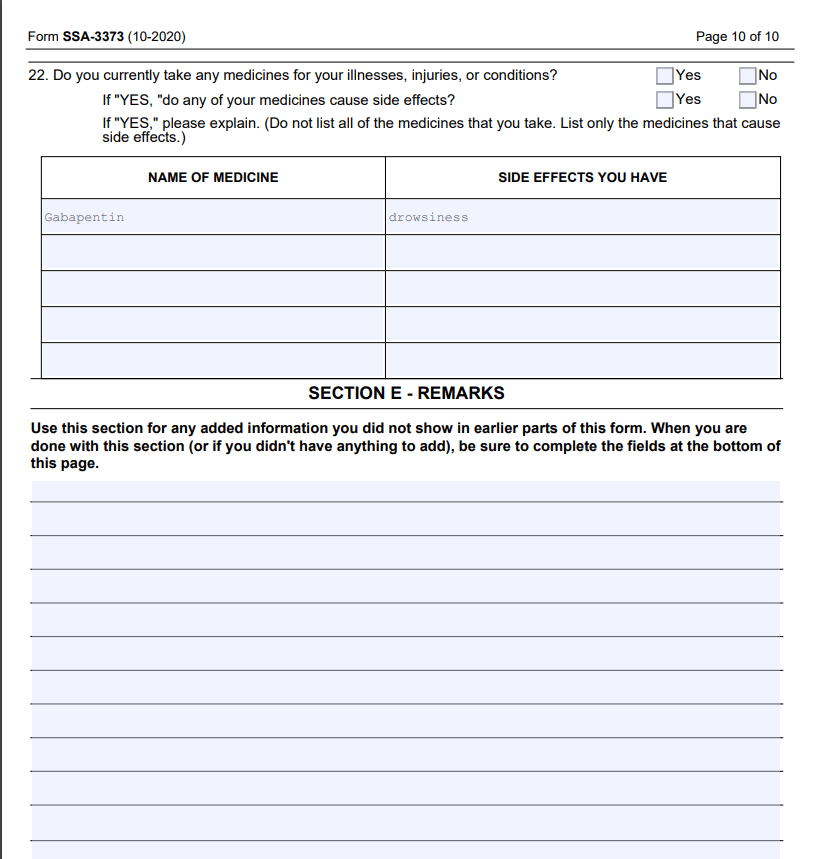
2
2 This guide is intended to be for informational purposes only and should not be construed as legal advice. Your answers should be honest, in your own words, and based on your own specific circumstances.











